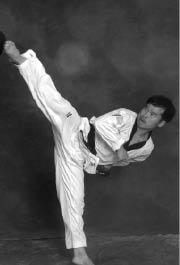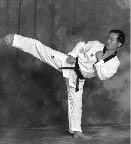Complete Kicking (3 page)
Authors: Turtle Press

Head up stabilizes your posture and integrates the body’s force.

Kicking Physics
In the science of kicking, there are three axes of the body: torso, thigh, and shin. Each transmits force and the further a point is from the origin of the force the more potential force it carries.
The initial point of action is called the Action Point.
The multiplying point of force is called the Pivot Point, where mechanical force is magnified.
The effect of applying the action point is called the Reaction Point.
The striking spot is called the Impact Point.
The primary pivot point in the body is the lower abdomen which facilitates force magnification between the action point and reaction point.
* The best exercise for strengthening the pivot point (abdomen) is sit-ups.
For right leg roundhouse kick, the origin of force is the left shoulder (action point). The force passes through the lower abdomen (pivot point) and is magnified at the knee (reaction point) which propels the the foot toward the target (impact point).

UNDERSTANDING THE BODY
To advance in kicking practice, it is important to have some basic knowledge of how the body works, particularly the bones, joints and muscles. They are the three primary mechanical devices that maximize the impact of your kicks. When you understand how they work, you can fully take advantage of what you have available. Not only will your training be more effective, but you’ll be less susceptible to injury. If you don’t understand how your body works, you might work hard but risk poor results and even injury. So take a few moments and review this chapter before you get started.
the body structure
the torso
When your kicking form is correct, your torso stabilizes your body. If your form is incorrect, your torso can unbalance your body and reduce the power, height and speed of your kick. Because your torso is the heaviest and most cumbersome part of your body, it is important to keep it at the center of your movement and allow your arms and legs to rotate around the torso. Imagine that your torso is the eye of the hurricane of your movements.
the spine
The spine is a complex network of muscles, ligaments, bones, joints, cartilage and nerves that work together to support and mobilize the body: support to stand, walk and lift; mobility for movements such as turning, twisting, bending, jumping and kicking. Because the spine is the primary support and movement structure of the torso, it is very important to stretch the back properly before and after kicking for optimal flexibility.
the lower abdomen
Kicking power originates from the lower abdomen, also called the danjun or dantien. A sharp exhalation during the execution of each kick tenses the abdomen, increasing the power of the kick. Many martial artists combine this exhalation with a shout (called kihap or kiai).
the arms
For kicking, your arms aid in balance, acceleration and delivery of force. Because your arms can move freely on the horizontal, vertical or diagonal planes, they are excellent tools for counter-balancing the movement of your legs, particularly when learning a new kick. For example, when you learn the axe kick, sharply dropping your arms at your sides can help you raise your kicking leg higher.
the legs
The legs are the primary impact delivery tools for kicking, however they must work in concert with the rest of the body for optimum power, speed and flexibility. Kicking only with your legs will produce poor results and limit your potential for improvement. As you saw in Chapter 1, your legs are the transmitters of the power that originates in your hips and torso.
The legs also support and disperse the body’s weight. The knees in particular function to generate force in moving, lifting, and striking and to lessen the impact when landing or falling.
INTEGRATED MOVEMENT
Practicing kicking alone is not sufficient to improve your kicking skills. Be sure to include strength, timing, accuracy, balance, power and flexibility exercises in your workout sessions to develop your overall physical condition. By taking a whole body approach, your physical movements will become integrated and your confidence will increase.
Some sample exercises: 1. Plyometric jumping drills, 2. Resistance band training (upper body), 3. Core strengthening bodyweight exercises, 4. Resistance band training (lower body), 5. Anti-gravity exercises, 6. Dynamic isometric drills.*
*For more details, see Ultimate Fitness Through Martial Arts and Ultimate Flexibility
BALANCE: It’s about relationships
BALANCE IN KICKING requires an understanding of where the various parts of your body are located in relation to each other; where they are moving from and to; and how to orchestrate them to maintain your form throughout a kick.
THE KEY to this seemingly complex process is maintaining symmetry in your body, if not visually, then at least in terms of weight distribution.
FOR EXAMPLE, knee kick requires you to slightly hunch your upper body forward to balance the upraised knee. The same is true of axe kick. Because front kick travels more forward than upward, your upper body needs to decline slightly backward to balance the forward motion of your leg. Roundhouse kick and side kick require a similar decline of the upper body to balance the outstretched leg.
Every kick has a different balance angle:
Knee kick: forward hunch balances upraised knee

Axe kick: similar to knee kick balance

Front kick: slight upper body decline

Roundhouse kick: upper body declines in relation to upraised kicking leg

Side kick: upper body declines in relation to thrusting height of kicking leg

BALANCE IS ABOUT CENTERING
In any balancing activity, the most important thing is to center yourself. Relax your shoulders and arms to promote natural rhythm in your motions. Lower your center of gravity so that you feel comfortable and secure. Do not overextend your body.
Other books
The Cutthroat Cannibals by Craig Sargent
Abducted to Love: The Intergalactic Prince Series (SciFi Alien Romance) by Jill L. Sterling
Florida Heatwave by Michael Lister
Tierra de vampiros by John Marks
In the Flesh by Livia Dare, Sylvia Day
Camille by Pierre Lemaitre
Ex and the Single Girl by Lani Diane Rich
A Partridge in a Pear Tree by McCabe, Amanda
Lifeblood by Tom Becker